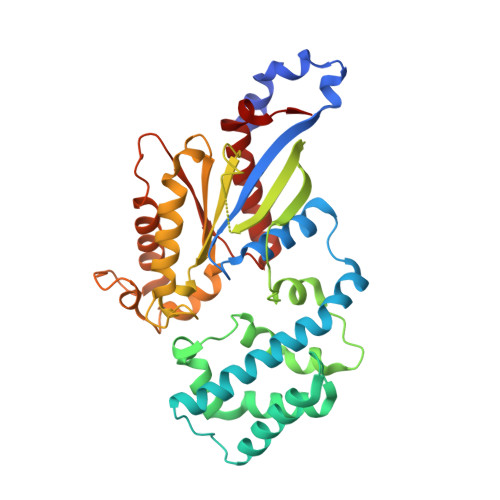A Conserved Phenylalanine as a Relay between the alpha 5 Helix and the GDP Binding Region of Heterotrimeric Gi Protein alpha Subunit.
Kaya, A.I., Lokits, A.D., Gilbert, J.A., Iverson, T.M., Meiler, J., Hamm, H.E.(2014) J Biological Chem 289: 24475-24487
- PubMed: 25037222
- DOI: https://doi.org/10.1074/jbc.M114.572875
- Primary Citation of Related Structures:
4PAM, 4PAN, 4PAO, 4PAQ - PubMed Abstract:
G protein activation by G protein-coupled receptors is one of the critical steps for many cellular signal transduction pathways. Previously, we and other groups reported that the ¦Á5 helix in the G protein ¦Á subunit plays a major role during this activation process. However, the precise signaling pathway between the ¦Á5 helix and the guanosine diphosphate (GDP) binding pocket remains elusive. Here, using structural, biochemical, and computational techniques, we probed different residues around the ¦Á5 helix for their role in signaling. Our data showed that perturbing the Phe-336 residue disturbs hydrophobic interactions with the ¦Â2-¦Â3 strands and ¦Á1 helix, leading to high basal nucleotide exchange. However, mutations in ¦Â strands ¦Â5 and ¦Â6 do not perturb G protein activation. We have highlighted critical residues that leverage Phe-336 as a relay. Conformational changes are transmitted starting from Phe-336 via ¦Â2-¦Â3/¦Á1 to Switch I and the phosphate binding loop, decreasing the stability of the GDP binding pocket and triggering nucleotide release. When the ¦Á1 and ¦Á5 helices were cross-linked, inhibiting the receptor-mediated displacement of the C-terminal ¦Á5 helix, mutation of Phe-336 still leads to high basal exchange rates. This suggests that unlike receptor-mediated activation, helix 5 rotation and translocation are not necessary for GDP release from the ¦Á subunit. Rather, destabilization of the backdoor region of the G¦Á subunit is sufficient for triggering the activation process.
Organizational Affiliation:
From the Departments of Pharmacology.



















